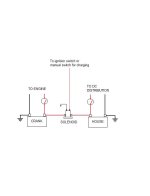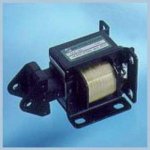I think that your proposed approach is lacking some information, and possibly some understanding. No offense, please.
1973 Browning Marine said:
1) Keep the engine system battery isolated or seperate from secondary battery system
2) Use the second battery for electronics
Your two concerns can be easily addressed without separating out your your hull's OEM wiring and charging system! There is NO need to do this, IMO. In fact, it will very likely further complicate things for you. Keep it simple!
You are going to have two battery banks, correct?
A dedicated starting Battery ..... aka "Cranking Bank", and a dedicated "House Bank", (aka "House Load Bank") for cabin lights, radio, heater fan, electronics, etc.
The House Bank will be ideally made up from one or more Deep Cycle batteries....
NOT a Cranking Battery.
The two are entirely different in construction and intended usage. Cranking for starting.... Deep Cycles for house bank.
You need a method for both isolating and selecting these battery banks.
I would use an
MBSS.... ( Main Battery
Selector Switch) ... key word being
"Selector".
(aka OFF/1/BOTH/2 switch like this one)
Here are the rear connecting terminals #1, #2 and "common".
The cranking battery is usually cabled to the #1 terminal, and the House Load Bank is cabled to the #2 terminal. Either bank remains isolated until either #1 or # 2 is selected.
Power then feeds through the "common" cable to the engine's starter motor. This is the point at which the Engine Harness and the Hull Harness interface with one another, and eventually power the helm.
The "common" cable doesn't know the difference, other than the available Amp Hours that can be supplied between the two entirely different battery types (heavy cranking amps -vs- the Amp Hours available from Deep Cycle batteries)!
Either can be selected, while the other is held in
"Reserve"..... key word = "Reserve".
This should cover your concern about the alternator taking a dump on you.
These two banks can become "combined" when the "BOTH" selection is made....... but this should be a rare occurance, and should NOT be done routinely, IMO.
Agian.... no matter which bank is selected, the engine harness/hull harness will not know the difference.
Likewise with alternator charging.... the alternator will charge which ever bank has been
"Selected".
These are "Make-before-Break" switches, so changing selection with engine running, is not an issues.
However, Do NOT switch to OFF with engine running!
Here is a basic schematic that is very simple, yet works tremendously well in most single engine boats.
I'm showing "new house loads", but pay no attention at this time. Just think in terms of your OEM hull harness and engine harness interface amd helm power.
I'm also showing 6 Volt House Bank Batteries paired up in series..... this is common for larger cruisers.... (more available Amp Hours w/ 6 volt batteries in series).
Yours can just as easily be 12 volt. Your call on that!

Note where the on board charger leads make their connection.
There is no need for any direct battery connections, other than battery cables ONLY. That's what the rear terminals are for.
An O/B Charger will still charge, regardless of MBSS position or selection, including OFF.
This also prevents the "rat's nest" at our batteries, and avoids small terminal corrosion.
Again, your call on that!
Ideally, we want to crank and warm engine on #1, and switch to #2 bank, keeping #1 in reserve for the day.
The bank that is currently selected, is being drawn from, and charged to via the engine alternator..... this includes House Loads!
NOTE: For a standard single engine system, people often confuse the separation of starting battery and house battery.
The ONLY separation takes place via the selection of the MBSS. Nothing else changes. A cranking bank will supply 12 vdc house load power...... likewise, a house bank will supply 12 vdc cranking power to the engine. It's just that these are the wrong battery types to be using inadvertently, and/or for any length of time. The two types have specific purposes.
So as you can see, an MBSS and two entirely different battery banks, requries that we manual manage these by selecting the intended battery bank. No big deal for most of us! We just get used to switching accordingly.
An ACR or a VSR can be added to take care of charging both banks automatically, regardless of MBSS selection.
There are also some great Bluesea products that further combine and isolate............ but that may be for another topic.
KIS.... Keep It Simple, and your system will be much easier to maintain and understand.







